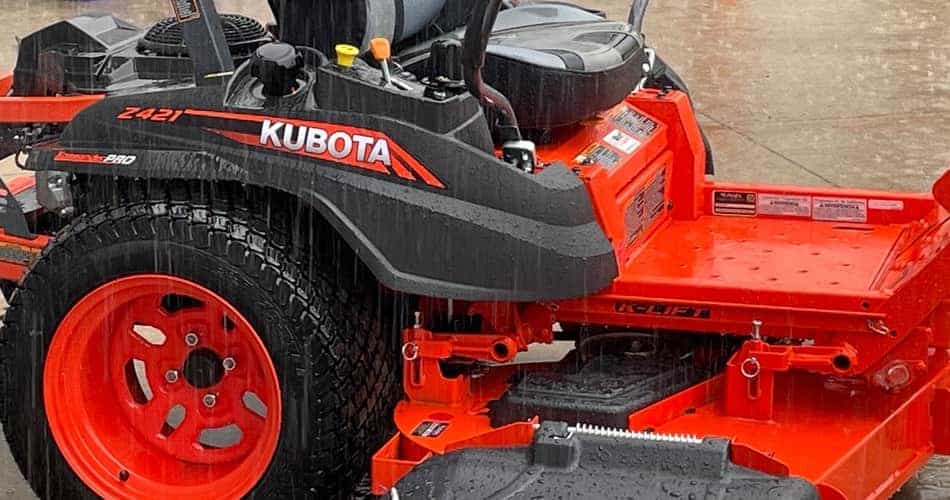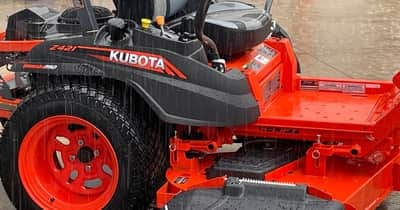You accidentally left your lawn mower in the rain and now it won’t start. I’ve gotten pretty busy and left my mower outdoors in a good rainstorm several times. It happens to the best of us.
We all make a mistake or two in the fast-paced world we live in. Whether it’s getting called into the office, running to pick up the kids after soccer practice, or grabbing dinner, we have all forgotten to put our lawn mower away and let it sit overnight in the rain.
What may cause your lawn mower to not start after leaving it in the rain?
Your mower may not start after leaving it in the rain because water may have gotten into the engine oil, fuel system, and electrical components like the ignition switch, safety switches, and spark plug boot.
Lawn mowers are not waterproof, but they can get wet. Some parts of your lawn mower can take a little bit of water, but not much.
It’s best not to let your mower sit outside in heavy or consistent rain. Your lawn mower can be used in light rain but you may not get the cut you want.
Mowing wet grass can cause the grass to clump and create buildup in the mower deck. This will not give you a nice cut. Running your mower through wet grass will make your tire tracks more pronounced.

This post may include affiliate links. Purchases made through these links may provide a commission for us, at no extra cost to you. As an Amazon Associate, we earn from qualifying purchases.
Follow all safety instructions provided in your equipment operator’s manual prior to diagnosing, repairing, or operating.Consult a professional if you don’t have the skills, or knowledge or are not in the condition to perform the repair safely.
6 Steps to Complete When Your Mower Doesn’t Start After Getting Wet
1: Dry the Mower Out
Letting the mower dry out will help the engine start. Grab a leaf blower or an air compressor with an air gun to blow the unit off. Using these items will help speed up the process of drying out the mower.
If you don’t have either of these options, placing the unit outdoors on a warm day will help dry it out. Just make sure you check the weather forecast so your mower isn’t left outside in the rain again.
A nice breeze outdoors will also assist with drying out our mower.
2: Check Engine Oil for Water
The next thing you need to do is check the engine oil to make sure water did not get into the crankcase. If the oil appears milky white in color, there is water in the oil. Go through your regular oil change routine to change the engine oil.
Water and oil don’t mix so not changing the engine oil can cause major damage to the internal working parts of your engine. See my article on changing engine oil in a push mower or riding mower.
3: Check for Dry Air Filter
You need to check the air filter. If water got into your oil, chances are water got into the crankcase through your air filter. Pull the air filter out.
You should replace a paper air filter with a new filter. You can try to let the paper filter sit in the sun to dry out, but it will not give you the 100% protection you need in a filter the next time you mow the lawn.
If your filter happens to be a sponge type of filter, just ring it out the best you can, and let it sit in the sun to dry out. Once it is dry, put some air filter oil on it, ring it out and install it back into the housing.
Your foam air filter needs to be oiled to keep dust particles from entering your engine and wearing out your internal engine components.
4: Check Fuel Tank for Water
You may wonder why you are checking the fuel tank. The fuel tank needs to be checked because the cap has a vent on it. If your mower sat through a hard rain chances are water got into the fuel tank. Water does not burn in a combustion chamber.
Water can dilute the fuel so bad it may not run at all. If you find water in your fuel tank, drain the fuel into a safe container and bring it to a recycling center. Refill with fresh fuel. Change your fuel filter if your mower is equipped with one.
Remember fuel usually has a 30-day shelf life before it starts to lose its pop. If you can’t get all of your fuel drained, you can try using a fuel stabilizer additive like STA-BIL and Sea Foam.
I like to run a fuel additive every other time I fill my mower just to help keep the condensation out of my tank in the summer. It’s especially helpful if you live in a very humid area or near water like a pond or lake.
Check out “Why Use Sea Foam Fuel Additive in a Lawn Mower” to see why I prefer Sea Foam to other fuel additives for your lawn mower.
5: Check Electrical Components Connections
Start with the ignition switch, if your mower has one, and the spark plug boot. Use some WD-40 and spray inside your ignition switch.
Remove the spark plug wires off the spark plug and spray the boot and wire the best you can. This will help displace the water that may be in the connections.
If you have a mower with several safety switches you might want to spray them down too. You have to remember water likes to travel the path of least resistance. Switches may be a place with water will collect.
6: Start Your Mower & Lubricate Cables
It’s time to start your mower up. It may take a pull or two or a couple of turns of the key, but it should fire up. Your mower may smoke a bit initially while it’s trying to get water out of the system.
You will probably notice a dirty-looking liquid coming out of the engine area.
Most likely it’s just rainwater, oil, and dirt mixed together. Once the engine is brought up to operating temperature it should stop.
Now that you have your lawn mower running you’re going to want to take your WD-40 and lubricate your choke and throttle cables in addition to any wires that have water on them to keep them dry and freed up.
If you don’t get the WD-40 in the conduit of the cables, the cables can rust up or freeze in the fall when the temperatures become cooler.
Lawn Mower Storage to Keep Out of the Rain
It’s best to keep your mower out of the rain. A garage, pole barn, or other storage sheds will work. This is great if you have the room, but what if you don’t?
That is the problem I had. I stored my mower under my deck to keep it out of most of the weather elements.
Water still dripped between the deck boards onto my mower so I bought a waterproof cover for my zero-turn. This cover kept the mower dry when outdoor storage was my only option.
It’s also a nice thing to have for long-term indoor storage.
Push Mower Marine Grade Cover
Riding Mower Marine Grade Cover
Zero Turn Marine Grade Cover
